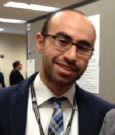More than 400 abstracts—a record—were submitted for the 27th Annual Meeting of the American Society of Pediatric Hematology/Oncology in Chicago. Here is a small sampling of those studies, with comments from the abstract authors.
Token Economy to Improve Compliance
BMT Bucks form the basis of a token economy created at Children’s Mercy Hospital in Kansas City, Missouri, to improve patient compliance with the often grueling, lengthy hospital experience for children undergoing bone marrow transplantation (BMT). Patients earn $1, $5, and $10 bills personalized with their photo for cooperating with daily hospital tasks, such as taking medicine on time, brushing their teeth, and permitting unpleasant procedures such as dressing changes (Abstract 2056).
Ronald Jones, physician assistant, author of the abstract and the original grant funding the program, now retired, explained that the hospital’s Child Life staff interview patients and their parents to determine what items patients would want and bring those items to the hospital where patients can “purchase” the items with BMT bucks. For a young child, it could be a toy, and for adolescents and young adults, it could be iTunes.
The price is not based on real dollars, but rather, BMT bucks as determined by the Child Life staff. The program is funded by a nonprofit organization at the hospital—the Cancer Care Committee—and available to every patient receiving BMT, which Mr. Jones estimated was about 45 to 50 patients per year.
“Changes in the emotional atmosphere of the BMT Unit were immediate and dramatic. What had been a stressful environment became a positive one where the children themselves expressed pride in their accomplishments. Although initially designed as a pilot study, nursing staff and parents were insistent on continuing the BMT Bucks program,” according to the study abstract.
Another advantage of the program is that it provides structure to the patient’s experience. “One of the ideas of a token economy is for the child to place value on something that for him has no inherent value,” such as taking a pill or bath, Mr. Jones explained to The ASCO Post.
For now, the evidence on outcome is anecdotal, Mr. Jones said. “Obviously, if someone takes all their medicines on time, their transplant is going to go smoother and they are going to have fewer problems.” Controlled research “may reveal what we currently suspect—that not only is the experience enhanced, but that by improving compliance, outcomes may also be improved,” the abstract noted. “The hard part is you would have to study that with and without the Bucks program,” Mr. Jones said. “In our case, once the Bucks program was in place for that pilot year, nobody wanted to stop it.”
Fertility Preservation Among Girls
In a study presented by Chicago researchers, histologic samples of ovarian tissue from 25 pediatric patients undergoing ovarian tissue cryopreservation found preantral follicles in all samples (Abstract 2059). The patients ranged in age from 2 to 17 years and exhibited a wide distribution of both cancer and noncancer diagnoses, including solid tumors (24%), leukemias/lymphomas/myelodysplastic syndromes (56%), and hematologic disorders (16%). At the time of cryopreservation, 52% had received previous therapy (surgery, chemotherapy, radiation).
“These findings are promising for fertility preservation using [ovarian tissue cryopreservation] and suggest that ovarian tissue from a pediatric population is likely to contain follicles regardless of age, disease diagnosis, treatment history, and specimen processing methods,” the authors concluded.
Ovarian research tissue was obtained from the Oncofertility Consortium’s National Physician’s Cooperative under institutional review board–approved protocols, with 80% of the removed tissue for each patient cryopreserved for future clinical use and the remaining 20% designated for research after informed consent.
“We use that tissue to do basic research to further understand these tissues and how best to use them for these patients,” the study’s lead author, Francesca E. Duncan, PhD, of the Department of Obstetrics and Gynecology, Northwestern University, Feinberg School of Medicine, Chicago, explained in an interview with The ASCO Post.
“Fertility preservation in a female pediatric population is challenging because standard assisted reproductive technologies may not be possible due to premenarchal status or the inability to delay cancer treatment. For these patients, ovarian tissue cryopreservation to preserve the primordial follicles within the ovarian cortex may be the only option. This tissue can potentially be used for transplantation to restore endocrine function and/or fertility,” the abstract authors noted.
Study coauthor Sherif M. Badawy, MD, of Ann & Robert H. Lurie Children’s Hospital, Northwestern University, Feinberg School of Medicine, told The ASCO Post that more families are becoming aware of the challenges of preserving fertility in young children treated for cancer, and in the long-run, new fertility options being studied could change the standard of care for young patients.
Transplantation of tissue could be contraindicated in some cases, such as ovarian cancer, “because you could potentially reintroduce the cancer,” Dr. Duncan stated. For those cases, “we are also developing new technologies, where you actually remove the follicles from the tissues completely and grow them in an artificial ovary. That would get rid of any contaminating cancer cells. This technique is in the emerging stages and has only been performed in a research setting,” she noted.
Obesity Risk in ALL Survivors
Although obesity is a well-established late effect following treatment of acute lymphoblastic leukemia (ALL) in childhood, and a major source of morbidity and reduced quality of life, parents are often unaware of the risks. “Unlike other late effects of therapy, obesity is potentially modifiable, making it critical to ensure that patients and families are aware of these risks,” according to a study by Gary L. Jones, DO, of Children’s Mercy Hospital, Kansas City, Missouri, and colleagues (Abstract 2043).
Data were collected during routine follow-up in the hematology/oncology clinic for 99 patients who completed ALL therapy. Median time from the end of therapy was 34 months.
One hundred and twenty-one parents completed a questionnaire while in clinic to evaluate their thoughts on their child’s diet, weight, activity level, and the obesity education provided by their practitioners. At the time of survey, 52 patients (53%) met Centers for Disease Control criteria for overweight (≥ 85th percentile), with 26 (26%) meeting criteria for obesity (≥ 95th percentile). Forty-two of the overweight patients (80%) were identified as “overweight” by their parents.
The majority of the parents of overweight and obese children (93% and 64%, respectively) did not recall discussing weight with their medical team following therapy. Of all 121 parents, 60% did not recall a discussion regarding obesity risk in ALL survivors, including 82% of the parents of obese children.
“I think the discussion does occur, but we probably need to change how we address it or the emphasis we place on it,” Dr. Jones told The ASCO Post. “That is going to be our next step.”
One of the problems, he said, is that during therapy, children often don’t want to eat, so parents will give the children whatever they will eat, including junk food, which can establish a pattern that contributes to obesity in the long-run. Continuing discussions about weight, diet, and maintaining activity throughout the term of care could remind parents about avoiding obesity risks.
Substituting Intrathecal Cytarabine for Methotrexate
Intrathecal cytarabine “appears to be a tolerable substitution for intrathecal methotrexate when necessary” to reduce neurotoxicity, according to a study by Suzanne Lewis, MD, and colleagues from The University of Texas Health Science Center at San Antonio (Abstract 2048).
In a retrospective chart review of 400 oncology patients treated at the Health Science Center between 1997 and 2013, the medical records for each patient were searched individually for documented central nervous system (CNS) toxicity from intrathecal methotrexate and subsequent use of cytarabine. “There was quite a variety of neurotoxicty that patients had—from seizures to loss of bladder control—and all patients seemed to tolerate the [cytarabine],” Dr. Lewis said in an interview with The ASCO Post.
Charts were available for 10 of the 14 patients (3.5%) identified as having experienced a CNS event attributed to intrathecal methotrexate and subsequently switched to intrathecal cytarabine. None of those patients experienced any neurotoxic events subsequent to the intrathecal cytarabine. Eight of those patients completed therapy with cytarabine as the prophylactic intrathecal agent, and seven were in their first clinical remission, with an average of 3.6 years off therapy.
“The only relapse we had was a bone marrow relapse, which as far as we could tell was unrelated to the intrathecal therapy,” Dr. Lewis noted. Two patients were still receiving chemotherapy, including intrathecal cytarabine injections without complications.
Dr. Lewis said that a new formulation of cytarabine has different absorption properties, and it is unclear how these results will apply to the new formulation.
Zoledronic Acid in Osteosarcoma Patients
A retrospective study suggests that maintenance chemotherapy with zoledronic acid may offer a survival benefit to patients with high-risk osteosarcoma (Abstract 2102). Zoledronic acid was well tolerated in the study, and 10 of 15 patients are alive at a median follow-up of 42 months.
The study involved 15 high-risk pediatric patients (10 males) with osteosarcoma considered “high risk” and treated with zoledronic acid as maintenance therapy after completion of chemotherapy over the past 5 years.
“We defined ‘high risk’ as poor histologic response, relapse < 24 months since diagnosis, multiple relapses, metastatic disease, or unresectable disease,” Amina Rafique, MD, of Rush University Medical Center, Chicago, explained.
All patients had documented osteopenia, and all were treated with a dose of 2.3 mg/m2 (to a maximum of 4 mg). A total of 159 doses of zoledronic acid were administered, with a mean of 10.6 doses, and the average age at start was 17.
“The next step is to calculate event-free survival,” Dr. Rafique told The ASCO Post, “and how many of these patients are actually disease-free.” ■
Disclosure: Drs. Duncan and G.L. Jones reported no potential conflicts of interest.







